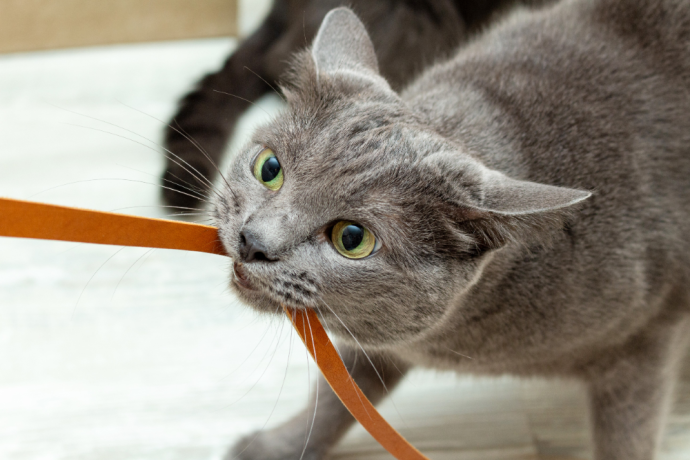How Do I Introduce My Cat To A New Kitten? 7 Steps To Introduce Cats to Each Other
Written by:
Author: Seb Jenkins
Seb is a professional SEO writer with a degree in Journalism, he has five years of experience in writing and editing. Seb specializes in topics like dog and cat breeds, aquarium guides, and pet care. He is passionate about educating and entertaining animal owners worldwide. In his spare time, Seb enjoys writing fiction novels.
View all 83 articlesLearn about our editorial process and veterinary review board.
Viewed: 97
Updated on: 06/08/2023
Bringing a new kitten home for the first time should be a joyous experience. However, it would help if you remembered that not everyone in your family may be aware of the kitten’s arrival. If you already have another cat living with you, it can be shocking to see another feline arriving in their territory. As such, you have to introduce your cat and your kitten correctly. Fortunately, we have created an all-you-need-to-know guide on exactly that!
Preparing a home for a kitten
When you bring a new kitten home for the first time, you need to make sure they have everything they need to remain healthy and comfortable. This stuff should all be purchased and introduced into the home before the kitten arrives.
It is also best for a kitten to be confined to one singular room that can be sealed off from the rest of the house in the early days. If you already have another cat, choose a room they don’t use that much. The last thing you want to do is pick their favorite room and take away their napping spot.
This kitten room should include food, water, a sleeping area, hiding places, a scratching post, a litter tray, and toys to keep them entertained. We recommend that you either use the stuff that came with the kitten or you buy brand-new stuff. If you try to re-use some of your existing toys, they may make your kitten uneasy due to the cat smell.
Talking of smells, it is always a great idea to use some feline pheromone in the kitten’s room and in the area where your existing cat spends most of their time. This will make both cats feel familiar with each other before they even meet.
RELATED: How to Raise a Kitten: Veterinary Advice
Giving your new kitten a routine
It is important to instill a healthy routine from an early age when you welcome a new kitten into the home. Give your new cat plenty of time to get used to these routines and all the people that live within your house.
Your kitten will spread their scent around the room by rubbing face glands against furniture and walls and using the scratching post. The same thing occurs naturally when the kitten sleeps on the bedding you provided too.
Some kittens take just a few days to acclimatize to their new surroundings and get used to their new routines. While others can take a week or two. You will know when they are comfortable by their actions.
For example, they may greet you in a friendly way when you enter the room, including meows and rubbing around your legs. They may also rest with their belly exposed, play with the toys provided, rub their face on furniture, and show normal eating/drinking/toilet activities.
On the other hand, your new kitty may seem frustrated with their current living quarters as they want a little more space. This can be seen via actions such as scratching at the door, meowing for minutes, pacing up and down beside the door, and swiping their paws at you when you leave.
If this is the case, let them have access to another room or corridor that your existing cat cannot gain access to. If this is not possible, you may have to start the introduction earlier than you expected.
READ MORE: How to know Cats are Playing or Fighting?
Steps to gradually introduce cats to each other –
When introducing a new kitten to your existing cat, you should take a number of steps to ensure the process goes smoothly. The idea is to gradually introduce them rather than sitting them down face to face immediately. Remember, the new kitten is nervous and invading your existing cat’s space.
Step 1 – Scent Swapping
You want to introduce the scent of each cat to the other without them actually meeting. As we said above, you can create a communal smell by using pheromones in both areas. You can also wrap a cat in a blanket and then introduce that blanket to the other cat. The idea is to make them feel like the same social group because they recognize each other’s smell.
Step 2 – Bedding Swap
Take part of each cat’s bedding and swap it to introduce them to each other’s scent. The idea is to create one shared communal scent they can get used to, which will make introductions much easier.
If both cats sleep on the swapped bedding, great news! You can keep moving ahead with the steps. However, if one or both actively avoids the bedding or hisses at it, you must proceed slower.
Step 3 – Exploration
If both cats seem comfortable, you can now let them explore each other’s domain. For example, you can confine your existing cat in your bedroom for one night and let the kitten explore the wider house. You can also confine the kitten in a different room for a day and let your existing cat explore the kitten’s room. Only do this once the kitten has been home for a few days and seems comfortable.
Step 4 – Visual Contact
It is now time to let your cat and kitten see each other for the first time. This should only be done once they are completely relaxed about the first three steps. In this step, you should let them see each other but keep them physically apart. You can hold a door ajar so they can see through but not pass through. You can use a mesh barrier, a glass door, or a children’s safety gate.
Step 5 – Supervised Contact
It is now time to let your cat and kitten have a physical introduction; however, this must be supervised. Remove the barrier slowly and quietly, ideally when both cats are in a good mood (playing or eating works best). Do not force them together, just observe. You are looking for them to seem comfortable around each other, even if they do not physically interact. If one cat seems distressed or aggressive, put the barrier back and return to visual contact only. If they both seem relaxed, keep up with these supervised contacts.
Step 6 – Physical Contact
The next step is unsupervised physical contact sessions, but only for short periods of time. The new kitten should return to their own space in between these frequent sessions. As long as both cats seem comfortable with these meetings, you can keep doing it for longer and longer periods of time. During these contacts, make sure both cats have their own resources like food and water still, in order to make them feel as though they do not have to compete.
Step 7 – Happy Days
Both cats should now feel completely comfortable with each other and maybe they are even friends! You should be able to leave them alone together for long periods of time without worrying. If one cat seems uncomfortable or aggressive, do not be afraid to go back a step or two.
READ MORE: How To Bond With Your Cat
Problems and Proofing Behavior
Never give up if the first meetings between your cats do not go well. It can take time for two cats to become accustomed to one another, particularly with older cats who have been used to having the house to themselves. Do not rush things and do not get frustrated. Go step by step, remain calm, and go back a step if needed.
READ MORE: Adopting an Adult Cat: What Should I Know (Veterinary Advice)
FAQs
How long does it take for a cat to get used to a new kitten?
This differs from cat to cat. Some will love having some company around the home while others will feel protective over their territory. Generally, if you follow our step-by-step guide, most cats get used to a new kitten within a week or so. But take the process at your own pace as every cat is different.
How do you introduce a kitten to a cat quickly?
Introducing two cats for the first time is not something to be rushed. If you throw them together without any preparation, you may do more harm than good and create a rivalry that is hard to break. Follow our step-by-step guide for the fastest way to introduce your cats effectively.
Can I introduce my kitten to my cat straight away?
You should not let your kitten meet your cat straight away. This could result in your kitten feeling uncomfortable and/or your cat feeling protective over their territory. Instead, you should introduce them bit by bit over a period of time, as detailed in our step-by-step guide above.
Should I let my cat hiss at the new kitten?
If your cat is hissing at your kitten then it is a clear sign they are not ready to be introduced. Letting your cat kiss can make the kitten feel uncomfortable and nervous. Simply remove them from the situation and go back a step on our guide which is detailed above.
 Kitten Care Why Do Kittens Bite? Reasons Why Do Kittens Bite And Ways To Stop Your Kitten Biting You
Kitten Care Why Do Kittens Bite? Reasons Why Do Kittens Bite And Ways To Stop Your Kitten Biting You - 176
- 0
 Cat Care Why Does My Cat Attack My Legs? 10 Reasons Why and What To Do About It (Vet-Approved Advice)
Cat Care Why Does My Cat Attack My Legs? 10 Reasons Why and What To Do About It (Vet-Approved Advice) - 46013
- 21
 Cat Veterinary Tips Cat Stomach Gurgling: Vet Advice on Why is Your Cat Stomach Gurgling?
Cat Veterinary Tips Cat Stomach Gurgling: Vet Advice on Why is Your Cat Stomach Gurgling? - 36469
- 4
 Cat Veterinary Tips My Cat Lost its Voice: Can Cats get Laryngitis? (Vet Advice)
Cat Veterinary Tips My Cat Lost its Voice: Can Cats get Laryngitis? (Vet Advice) - 23554
- 13

























